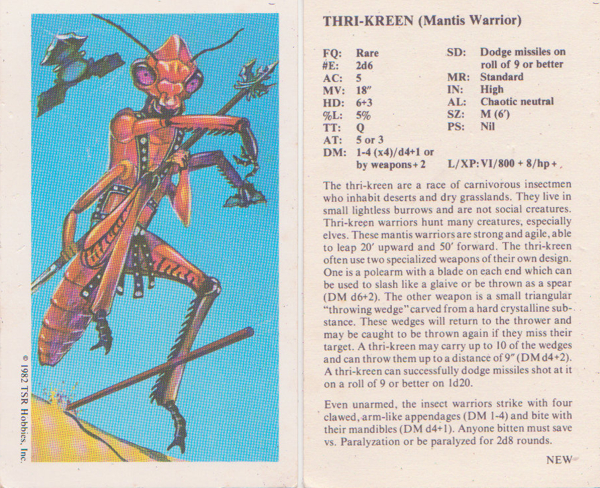Monster Manual Excerpt: Thri-Kreen
Athas.org is given a Monster Manual exclusive preview, the Thri-Kreen.
Thri-Kreen wander the deserts and savannas of the world, avoiding all other races.
The above quote from the new Monster Manual (Due out September 30th) described Thri-Kreen as they may appear in most standard D&D worlds. As we all know Dark Sun is far from standard. From the very inception of Dark Sun in the Original Dark Sun boxed set Thri-Kreen were heavily featured and available as a player character race.
With their four arms, carapace armor, leaping ability, and paralytic bite, the mantis warriors were a powerful race. In 2nd edition AD&D that power was limited by a short lifespan, trouble understanding and being understood by other denizens of Athas, and an inability to use many magic items and armor due to their odd insectoid body shape.
Origins

Thri-Kreen first appeared in the Dungeons & Dragons game with the Monster Cards accessories in 1982. From there they were published in the Monster Manual II for AD&D 1st edition in 1983. Following that they were included in the Forgotten Realms setting in 1989. After they appeared in Dark Sun, Thri-Kreen have been heavily tied to psionics and were included in several Psionic related books for 3rd edition D&D.
Appearance
Thri-Kreen are mantis men, with six limbs, four of which are arms, the remaining two are legs which were powerful and could propell them with huge leaps.. They are covered in chitinous plate armor and their mandibled mouths produced a paralytic poison that they could also use to fuse sand together to make crystaline weapons.
Thri-kreen appearance has mostly remained unchanged since their inception, with the exception of the abdomen. Up until 3rd edition Dungeons & Dragon Thri-kreen always had a large abdomen, giving them a very non-human appearance. With the 3rd edition Shining South book and for Dark Sun fans the 4th edition Dark Sun Campaign Setting their large abdomen was removed which resulted in a much more humanoid shape. One other notable change in their appearance is their second set of arms. In 2nd edition and prior, both their primary and secondary sets of arms were the same size, but in later (and the current incarnation) the secondary set of arms is smaller.




 The figures given above are for mature adult thri-kreen. Others have the following abilities, based on their age (they age one age category per year until they reach mature adult):
The figures given above are for mature adult thri-kreen. Others have the following abilities, based on their age (they age one age category per year until they reach mature adult):



